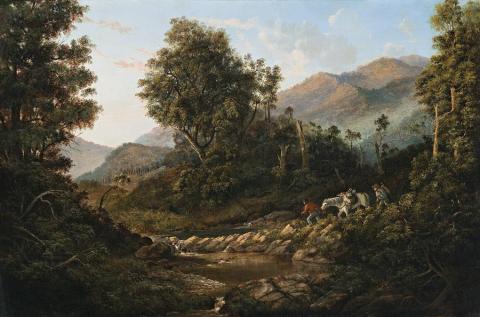GOLD PROSPECTORS CROSSING A STREAM, c.1875
Isaac Whitehead
oil on canvas
60.5 x 91.5 cm
signed lower left: I. Whitehead
Private collection, Melbourne
Deutscher Fine Art, Melbourne
Private collection, Melbourne
Lauraine Diggins Fine Art, Melbourne 1999
Private collection, Victoria
Australian Art: 1820/1920, Deutscher Fine Art, Melbourne, 3 – 21 November 1980, cat 34
Annual Collectors' Exhibition 1999, Lauraine Diggins Fine Art, Melbourne, 5 June – 3 July 1999, cat. 4, (illus.)
The subject of gold was almost as valuable to the nineteenth-century Australian artist as the precious metal itself. Artists of the likes of Eugène von Guerard and George Rowe joined the Victorian gold rushes before they gave up the miner's pick for the paintbrush. Others, such as William Strutt, Ludwig Becker, and S. T. Gill, were fascinated by the phenomenon, and recorded the extraordinary scenes at Ballarat and Bendigo for a worldwide audience. Not all focused on the diggings. Some captured moments when successful diggers were badly dealt with by gold buyers and bushrangers, others looked at the spectacle of the tent cities and boom towns, while again others saw the prospectors finding their way through the Antipodean wilderness in search of the geological signs that said gold was here. Isaac Whitehead chose the latter, his painting also being a visual metaphor for a land of opportunity. As the two prospectors and their laden packhorse prepare to ford a stream, the surrounding bush is bathed in a golden glow of promise, the whole blending adventure and romance of the hunt with a Neo-classically inclined composition, touched with the Picturesque.
Whitehead was well-regarded by his contemporaries, not only as maker of the finest frames for Messrs Von Guerard, Louis Buvelot and other leading artists of the time, but also as an artist of much sensibility. In the catalogue to the Victorian Intercolonial Exhibition of 1875, it was noted that, 'Another aspirant for fame as a delineator of Australian scenery is Mr Isaac Whitehead, who during the last three or four years, has made wonderful progress, and may now be said to be most successful in reproducing upon canvas the distinctive features of the scenery he portrays.'1 Whitehead exhibited Spring Morning and Noon on the Yarra Flats, gaining a medal for his participation. He played a prominent role in Melbourne society through his highly successful business and artistic pursuits. These included participation in the Melbourne Internationals of 1879 and 1880; and the Paris Universal Exhibition of 1878, for which he was awarded a silver medal. A foundation member of the Victorian Academy of Arts, Whitehead exhibited regularly in its annual exhibitions, as well as in Sydney. The regard in which his paintings were held by his contemporaries went beyond his lifetime, his works being shown posthumously in the Victorian Jubilee Exhibition of 1884, the London Colonial and Indian Exhibition of 1886, and the Melbourne Centennial Intercolonial Exhibition of 1888. Whitehead's paintings capture the sublime grandeur of nature, of majestic mountains, stately gums and fern tree gullies, especially in the Dandenongs and other such scenic spots of Victoria.
1. Victorian Intercolonial Exhibition 1875; Preparatory to the Philadelphia Exhibition 1876', Official Catalogue of Exhibits, Melbourne, 1875, p. 208
DAVID THOMAS
